
Argentine peso moneda nacional
Encyclopedia
The peso moneda nacional was the currency of Argentina
between November 5, 1881 and December 31, 1969. It was subdivided into 100 centavo
s, with the argentino worth 5 pesos. Its symbol was m$n or $m/n. Its ISO 4217
code was ARM.
at a rate of one to eight. It also replaced the peso fuerte at par and the peso moneda corriente
at a rate of 25 pesos monedas corrientes = 1 peso moneda nacional. The peso moneda nacional was itself replaced by the peso ley
at a rate of one hundred to one.
The peso was initially pegged to the French franc
at a rate of 1 peso = 5 francs. In 1883, when silver coins ceased production, the paper peso was set at a value of 2.2 francs or 638.7 mg gold. After a suspension in the gold standard from 1914, in 1927, a peg to the U.S. dollar was established of 2.36 pesos = 1 dollar. The rate changed to 1.71 pesos = 1 dollar in 1931, then to 3 pesos = 1 dollar in 1933. Between 1934 and 1939, the peso was pegged to the British pound at a rate of 15 pesos = 1 pound. High inflation in the post-war period lead to the introduction of the peso ley
in 1970 at the rate of 100 pesos monedas nacionales = 1 peso ley.

The first nationally issued banknotes were introduced by the Banco Nacional in 1884. These were in denominations of 5, 10, 20 and 50 centavos. In 1891 and 1892, the same denominations were produced by the Banco de la Nación Argentina. In 1894, the Banco de la Nación Argentina introduced larger denomination notes for 1, 2, 5, 10, 20, 50, 100, 200, 500 and 1000 pesos.
Paper money production was taken over by the Caja de Conversion in 1899. That year, 50 centavos, 1 and 100 pesos were introduced, followed in 1900 by notes for 5, 10, 50, 500 and 1000 pesos. These notes were issued until 1935, when the Banco Central began to produce notes.
These bank notes were created originally in a bigger size and printed by the mint (Casa de Moneda), using French-made paper.
Due to their size, and the paper not being of good enough quality, they began to deteriorate. They then decided to suspend the printing and look for another provider. The new notes, of smaller size, started to be issued in 1903, using typography
as the printing method.
The Banco Central issued the following banknotes:
Economy of Argentina
This article provides an overview of the Economic history of Argentina.-Emergence into the world economy:Prior to the 1880s, Argentina was a relatively isolated backwater, dependent on the wool, leather and hide industry for both the greater part of its foreign exchange and the generation of...
between November 5, 1881 and December 31, 1969. It was subdivided into 100 centavo
Centavo
Centavo is a Spanish and Portuguese word, derived from the Latin centum, meaning "one hundred", and the suffix -avo, meaning "portion" or "fraction"...
s, with the argentino worth 5 pesos. Its symbol was m$n or $m/n. Its ISO 4217
ISO 4217
ISO 4217 is a standard published by the International Standards Organization, which delineates currency designators, country codes , and references to minor units in three tables:* Table A.1 – Current currency & funds code list...
code was ARM.
History
The peso moneda nacional replaced the Argentine realArgentine real
The real was the currency of Argentina until 1881. From 1822, it was subdivided into 10 decimos. The sol was also issued during this period and was equal to the real, whilst the peso was worth 8 reales and the escudo was worth 16 reales....
at a rate of one to eight. It also replaced the peso fuerte at par and the peso moneda corriente
Argentine peso moneda corriente
The peso moneda corriente was a non-convertible Argentine paper currency which circulated between 9 January 1826, and 4 November 1881. Its symbol was $m/c. It was also known as the peso papel ....
at a rate of 25 pesos monedas corrientes = 1 peso moneda nacional. The peso moneda nacional was itself replaced by the peso ley
Argentine peso ley
The peso ley 18.188, usually known as either peso or, to distinguish it from the earlier peso moneda nacional, informally as peso ley, was the currency of Argentina between January 1, 1970 and May 5, 1983. It was subdivided into 100 centavos. Its symbol was $, sometimes $L. Its name comes from law...
at a rate of one hundred to one.
The peso was initially pegged to the French franc
French franc
The franc was a currency of France. Along with the Spanish peseta, it was also a de facto currency used in Andorra . Between 1360 and 1641, it was the name of coins worth 1 livre tournois and it remained in common parlance as a term for this amount of money...
at a rate of 1 peso = 5 francs. In 1883, when silver coins ceased production, the paper peso was set at a value of 2.2 francs or 638.7 mg gold. After a suspension in the gold standard from 1914, in 1927, a peg to the U.S. dollar was established of 2.36 pesos = 1 dollar. The rate changed to 1.71 pesos = 1 dollar in 1931, then to 3 pesos = 1 dollar in 1933. Between 1934 and 1939, the peso was pegged to the British pound at a rate of 15 pesos = 1 pound. High inflation in the post-war period lead to the introduction of the peso ley
Argentine peso ley
The peso ley 18.188, usually known as either peso or, to distinguish it from the earlier peso moneda nacional, informally as peso ley, was the currency of Argentina between January 1, 1970 and May 5, 1983. It was subdivided into 100 centavos. Its symbol was $, sometimes $L. Its name comes from law...
in 1970 at the rate of 100 pesos monedas nacionales = 1 peso ley.
Coins
In 1881, silver 10, 20 and 50 centavos and 1 peso and gold 1 argentino coins were introduced, followed by bronze 1 and 2 centavos the next year. Silver coins ceased production in 1883, with gold coins ending in 1896. Base metal 5, 10 and 20 centavos were introduced in 1896, with base 50 centavos following in 1941. The 1 peso was reintroduced in 1957, with 5, 10 and 25 pesos introduced in 1961, 1962 and 1964.Centavo
| Value | Obverse | Emission | Withdrawn | Composition | Diameter |
|---|---|---|---|---|---|
| 1 | Liberty | 1882 - 1896 | 21 April 1959 | Bronze | 25 mm |
| 1 | Coat of arms Coat of arms of Argentina The coat of arms of Argentina was established in its current form in 1944, but has its origins in the seal of the General Constituent Assembly of 1813. It is supposed that it was chosen quickly because of the existence of a decree signed on February 22 sealed with the symbol... |
1939 - 1944 | 21 April 1959 | Bronze | 16 mm |
| 1 | Coat of arms | 1945 - 1948 | 21 April 1959 | Copper | 16 mm |
| 2 | Liberty | 1882 - 1896 | 21 April 1959 | Bronze | 30 mm |
| 2 | Coat of arms | 1939 - 1947 | 21 April 1959 | Bronze | 20 mm |
| 2 | Coat of arms | 1947 - 1950 | 21 April 1959 | Copper | 20 mm |
| 5 | Liberty | 1896 - 1942 | 31 January 1965 | Copper-Nickel | 17 mm |
| 5 | Liberty | 1942 - 1950 | 31 January 1965 | Aluminium-Bronze | 17 mm |
| 5 | José de San Martín José de San Martín José Francisco de San Martín, known simply as Don José de San Martín , was an Argentine general and the prime leader of the southern part of South America's successful struggle for independence from Spain.Born in Yapeyú, Corrientes , he left his mother country at the... |
1950 - 1953 | 31 January 1965 | Copper-Nickel | 17 mm |
| 5 | José de San Martín | 1953 - 1956 | 31 January 1965 | Copper-Nickel clad steel | 17 mm |
| 5 | Liberty | 1957 - 1959 | 31 January 1965 | Copper-Nickel clad steel | 17 mm |
| 10 | Liberty | 1881 - 1883 | .900 Silver | 18 mm | |
| 10 | Liberty | 1896 - 1942 | 21 January 1966 | Copper-Nickel | 19 mm |
| 10 | Liberty | 1942 - 1950 | 21 January 1966 | Aluminium-Bronze | 19 mm |
| 10 | José de San Martín | 1950 - 1952 | 21 January 1966 | Copper-Nickel | 19 mm |
| 10 | José de San Martín | 1952 - 1956 | 21 January 1966 | Nickel clad steel | 19 mm |
| 10 | Liberty | 1957 - 1959 | 21 January 1966 | Nickel clad steel | 19 mm |
| 20 | Liberty | 1881 - 1883 | .900 Silver | 22 mm | |
| 20 | Liberty | 1896 - 1942 | 31 January 1967 | Copper-Nickel | 21 mm |
| 20 | Liberty | 1942 - 1950 | 31 January 1967 | Aluminium-Bronze | 21 mm |
| 20 | José de San Martín | 1950 - 1952 | 31 January 1967 | Copper-Nickel | 21 mm |
| 20 | José de San Martín | 1952 - 1956 | 31 January 1967 | Nickel clad steel | 21 mm |
| 20 | Liberty | 1957 - 1961 | 31 January 1967 | Nickel clad steel | 21 mm |
| 50 | Liberty | 1881 - 1883 | .900 Silver | 29 mm | |
| 50 | Liberty | 1941 | 31 January 1969 | Nickel | 24 mm |
| 50 | José de San Martín | 1952 - 1956 | 31 January 1969 | Nickel clad steel | 23 mm |
| 50 | Liberty | 1957 - 1961 | 31 January 1969 | Nickel clad steel | 23 mm |
Peso
| Value | Obverse | Emission | Withdrawn | Composition | Diameter |
|---|---|---|---|---|---|
| 1 | Liberty | 1881 - 1883 | .900 Silver | 39 mm | |
| 1 | Liberty | 1957 - 1962 | 1 October 1974 | Nickel clad steel | 25 mm |
| 1 | Buenos Aires Buenos Aires Buenos Aires is the capital and largest city of Argentina, and the second-largest metropolitan area in South America, after São Paulo. It is located on the western shore of the estuary of the Río de la Plata, on the southeastern coast of the South American continent... Cabildo |
1960 | 1 October 1974 | Nickel clad steel | 25 mm |
| 5 | Liberty | 1881 - 1896 | .900 Gold | 23 mm | |
| 5 | President Sarmiento frigate ARA Presidente Sarmiento ARA Presidente Sarmiento is a museum ship, originally built as a training ship for the Argentine Navy. She is considered to be the last intact cruising training ship from the 1890s.... |
1961 - 1968 | 12 April 1976 | Nickel clad steel | 21 mm |
| 10 | Gaucho riding horse | 1962 - 1968 | 12 July 1976 | Nickel clad steel | 21 mm |
| 10 | House of Tucumán House of Tucumán The House of Tucumán is a historical building and museum located in San Miguel de Tucumán, Argentina, where an assembly of delegates from several provinces of the country declared independence from Spain on 9 July 1816.Distinguishable by its Solomonic columns... |
1966 | 12 July 1976 | Nickel clad steel | 21 mm |
| 25 | First national coin | 1964 - 1968 | 12 July 1976 | Nickel clad steel | 26 mm |
| 25 | Domingo Faustino Sarmiento Domingo Faustino Sarmiento Domingo Faustino Sarmiento was an Argentine activist, intellectual, writer, statesman and the seventh President of Argentina. His writing spanned a wide range of genres and topics, from journalism to autobiography, to political philosophy and history... |
1968 | 12 July 1976 | Nickel clad steel | 26 mm |
Banknotes

The first nationally issued banknotes were introduced by the Banco Nacional in 1884. These were in denominations of 5, 10, 20 and 50 centavos. In 1891 and 1892, the same denominations were produced by the Banco de la Nación Argentina. In 1894, the Banco de la Nación Argentina introduced larger denomination notes for 1, 2, 5, 10, 20, 50, 100, 200, 500 and 1000 pesos.
Paper money production was taken over by the Caja de Conversion in 1899. That year, 50 centavos, 1 and 100 pesos were introduced, followed in 1900 by notes for 5, 10, 50, 500 and 1000 pesos. These notes were issued until 1935, when the Banco Central began to produce notes.
Issues 1899-1935
Law 3505, of 20 September, 1897, authorized the Caja de Conversión to renovate all paper money in existence at the time. They decided to make new design called "Progress's Effigy" ("Efigie del Progreso").These bank notes were created originally in a bigger size and printed by the mint (Casa de Moneda), using French-made paper.
Due to their size, and the paper not being of good enough quality, they began to deteriorate. They then decided to suspend the printing and look for another provider. The new notes, of smaller size, started to be issued in 1903, using typography
Typography
Typography is the art and technique of arranging type in order to make language visible. The arrangement of type involves the selection of typefaces, point size, line length, leading , adjusting the spaces between groups of letters and adjusting the space between pairs of letters...
as the printing method.
| Value | Issue dates | Image |
|---|---|---|
| 50 centavos | 1899-1900,1918-1926 |  |
| 1 Peso | 1900-1903,1906-1935 |  |
| 5 Pesos | 1900-1935 |  |
| 10 Pesos | 1900-1935 |  |
| 50 Pesos | 1900-1935 |  |
| 100 Pesos | 1899-1932 |  |
| 500 Pesos | 1900-1901,1905,1909-1930,1935 |  |
| 1000 Pesos | 1901,1905,1906,1908,1910-1934 |  |
The Banco Central issued the following banknotes:
| Value | Portrait | Back | Emission start date | Withdrawn | Image |
|---|---|---|---|---|---|
| 50 centavos | Republic face | National Constitution Argentine Constitution of 1853 The Argentine Constitution of 1853 was the first constitution of Argentina, approved with the support of the governments of the provinces —though without that of the Buenos Aires Province, who remained separated of the Argentine Confederation until 1859, after several modifications to the... |
1942 | 31 December 1960 |  |
| 1 | Justice | House of Tucumán House of Tucumán The House of Tucumán is a historical building and museum located in San Miguel de Tucumán, Argentina, where an assembly of delegates from several provinces of the country declared independence from Spain on 9 July 1816.Distinguishable by its Solomonic columns... |
1935 | 31 December 1960 |  |
| 5 | José de San Martín | May Revolution May Revolution The May Revolution was a week-long series of events that took place from May 18 to 25, 1810, in Buenos Aires, capital of the Viceroyalty of the Río de la Plata, a Spanish colony that included roughly the territories of present-day Argentina, Bolivia, Paraguay and Uruguay... |
1935 | 31 January 1965 |  |
| 10 | José de San Martín | Oath of Independence | 17 March 1936 | 31 January 1965 |  |
| 50 | José de San Martín | Passage of the Andes | 10 September 1936 | 30 March 1968 |  |
| 50 | José de San Martín | Passage of the Andes | 2 January 1943 | 30 September 1968 |  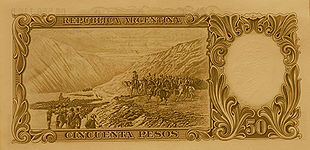 |
| 100 | José de San Martín | Buenos Aires Buenos Aires Buenos Aires is the capital and largest city of Argentina, and the second-largest metropolitan area in South America, after São Paulo. It is located on the western shore of the estuary of the Río de la Plata, on the southeastern coast of the South American continent... foundation |
14 August 1936 | 30 March 1968 |  |
| 100 | José de San Martín | Buenos Aires Buenos Aires Buenos Aires is the capital and largest city of Argentina, and the second-largest metropolitan area in South America, after São Paulo. It is located on the western shore of the estuary of the Río de la Plata, on the southeastern coast of the South American continent... foundation |
23 December 1943 | 30 September 1968 | 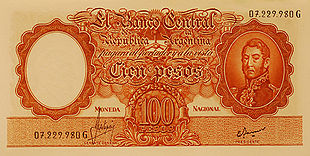  |
| 500 | José de San Martín | Argentine Central Bank Banco Central de la República Argentina -Overview:Established by six Acts of Congress enacted on May 28, 1935, the bank replaced Argentina's Currency board, which had been in operation since 1890... |
21 December 1944 | 30 March 1968 |  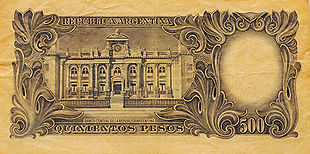 |
| 500 | José de San Martín | San Martín's house at Grand Bourg | 25 November 1964 | 30 September 1968 |  |
| 1,000 | José de San Martín | President Sarmiento Frigate | 21 December 1944 | 1 July 1975 | 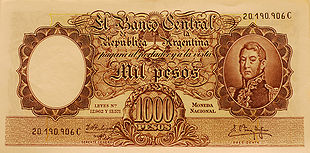  |
| 5,000 | José de San Martín | National Congress | 4 October 1962 | 1 July 1975 | 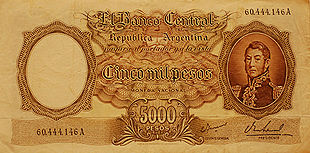 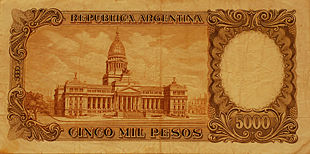 |
| 10,000 | José de San Martín | San Martín and O'Higgins Bernardo O'Higgins Bernardo O'Higgins Riquelme was a Chilean independence leader who, together with José de San Martín, freed Chile from Spanish rule in the Chilean War of Independence. Although he was the second Supreme Director of Chile , he is considered one of Chile's founding fathers, as he was the first holder... meeting |
18 December 1961 | 1 July 1975 |

